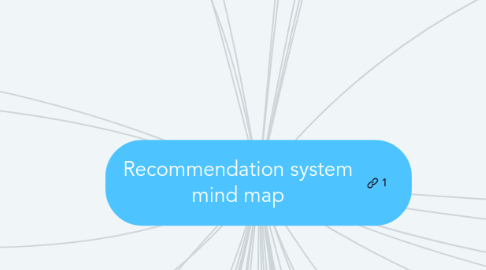
1. SVD-based algorithm
1.1. PureSVD
1.2. TruncatedSVD
2. T-trial payoff
2.1. Regret minimization
3. Replace missing entries with 0
4. Eigendecompostion algorithms
5. top-N recomendations
6. ranking mechnism
6.1. pointwise
6.1.1. NDCG
6.2. listwise
6.2.1. Directly optimize metrics
6.2.1.1. MAP
6.2.1.2. MRR
6.3. pairwise
6.3.1. Bayessian Personalized Ranking
6.3.2. Weighted approximate-rank pairwise
7. Feature based exploration/explotation problem
7.1. Exploit
7.2. Exploration
7.2.1. Can increaes short-term regret
7.2.2. Can reduce long-term regret
7.3. Set of arms (actions)
8. epsilon-greddy
9. Weighted matrix factorization
10. Switching
11. Biases
11.1. Baseline predictions
12. Content-based systems
13. Knowledge-based approach
14. Hybrid systems
14.1. Algorithms
14.1.1. Regulization
14.1.2. Weighted
14.1.3. Mixed
14.1.4. Meta-learned
14.1.5. Feature augmentation
14.2. Problems
14.2.1. Gray sheep users
14.2.2. Black sheep users
15. User experience
16. Matrix factorization
16.1. No the best choise for implicit case
16.1.1. Deep Learning based
16.1.1.1. Neural Collaborative Filtering
16.1.1.2. DeepMF
16.1.1.3. Variational Autoencoders for Collaborative Filtering (Mult-VAE)
16.2. Embedings
16.3. Loss function
17. Learning-to-rank
18. Bandits
18.1. Exploration strategy
18.1.1. EXP3
18.1.2. UCB1
18.1.3. Thompson sampling
18.2. Contextual bandit
18.2.1. Traits
18.2.2. Context
18.2.2.1. Current user
18.2.2.2. Feature vector
18.2.3. PayOff
19. Sacrifice the buisness metrics
20. Candidate generation strategies
20.1. TrainItems
21. RelPlusN
22. Unexepectedness metrics
22.1. Anonymys
22.1.1. Scalability
22.2. Problems
23. Intra-list diversity
24. Off-policy
25. Require existence of large community of users
26. Non-probabalistic
26.1. Item-based
26.2. User based
27. Pearson correlation
28. Memory-based
28.1. Matrix completion
28.2. Algorithms
28.3. Behaviour types
28.3.1. Items
28.3.2. Actions
28.3.3. Users
28.4. Behavioral similarity function
28.4.1. Spearman correlation
28.4.2. Cosine similarity
28.4.3. Jaccard index
28.4.4. Dice coefficient
28.5. Neighborhood formation
28.5.1. Select fixed number of nearest neighbors
29. Paralle ALS
30. Value-based
31. Problems
31.1. Extremely large action space
32. Percentage of users with at least one correct recommendations
33. Parallel SGD
33.1. Shared-memory approach
34. Lack of personalization
35. Offline Metrics
35.1. Precision-based
35.1.1. Precision@k
35.1.2. Recall@k
35.1.3. RMSE
35.1.4. MAE
35.1.5. Ranking metrics
35.1.5.1. NDCG
35.1.6. MAP
35.1.7. MRR
35.1.8. F-measure
35.1.9. AUC
35.2. Hit rate
35.2.1. Pairwise similarity
35.3. Development-based
35.3.1. CPU per cost
35.3.2. Diversity-based
35.4. Cost of re-training
35.5. Matrix factorization
35.5.1. Storage cost
36. SGD
37. Pre-filtering
37.1. Item splitting
37.2. User splittiing
37.3. Optimal splitting criteria
38. Collaborative filtering
38.1. Features
38.1.1. Cold start problem
38.1.2. Don't rely on metadata
38.1.2.1. Model-based
38.1.2.1.1. Markov models
38.1.2.1.2. Session-based recommendations
38.1.2.1.3. Algorithmns
38.1.2.1.4. User
38.1.3. Don't rely on content features
39. Evaluation
39.1. Online metrics
39.1.1. CR
39.1.2. Business-oriented metrics
39.1.2.1. CTR
39.1.2.2. GMV
39.1.3. Serendipity
39.1.4. Novelty
39.1.5. Coverage
39.2. Train/eval split
39.2.1. Time based
39.3. UserTest
40. Optimization techniques
40.1. ALS
40.2. CD
41. Parallel computation
42. Context-aware recommendations
42.1. Post-filtering
42.1.1. Deviation
42.2. Contextual modeling
42.2.1. Deviation based modeling
42.2.2. Similarity-based modeling
43. Reinforcement learning
43.1. Model-based
43.2. Policy-based
43.3. Model-free
43.3.1. On-policy
